December 27, 2019 feature
Elastic kirigami patch for electromyographic analysis of the palm muscle during baseball pitching
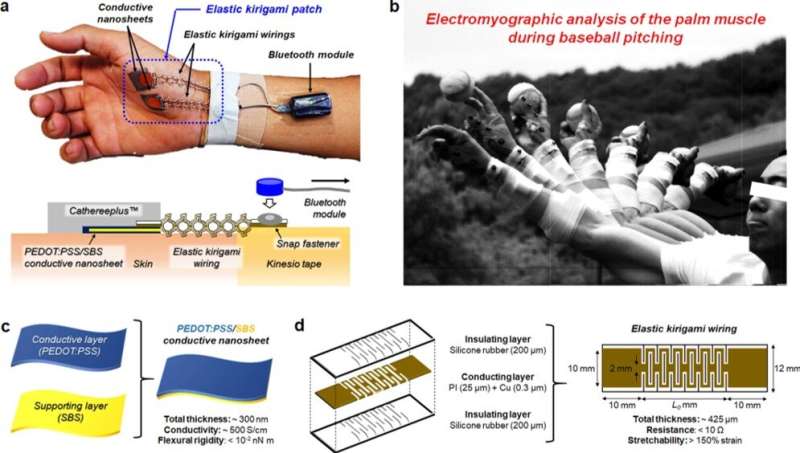
Surface electromyography (sEMG) is widely used to investigate human motion including athletic performance. Baseball pitchers require very precise movements to pitch the ball to the strike zone, where the palm muscle plays a key role during movement. Recording the sEMG from the palm can help analyze motion during baseball pitching, however, currently available devices are bulky with rigid electrodes that impede natural movement of the wearer. Kento Yamagishi and a team of researchers in the School of Advanced Science and Engineering, Faculty of Sports, and Digital Manufacture and Design in Japan, therefore described a new skin-contact patch. The wearable device contained kirigami-based stretchable wirings and conductive polymer nanosheet-based ultraconformable bioelectrodes. The research team designed the device to address the mechanical mismatch between human skin and electronics and published the results on Nature Asia Materials.
The device contained a kirigami-inspired wiring design and mechanical gradient structure from nanosheet-based flexible bioelectronics to form a bulk wearable construct. The design approach buffered the mechanical stress applied to the skin-contact bioelectrodes during an arm swing movement. More specifically, Yamagishi et al. measured the sEMG at the abductor pollicis brevis muscle (APBM) in a baseball player during pitching. The research team observed differences in the activity of the ABPM between different types of fastball and curveball pitches. The outcomes will allow them to analyze motion in unexplored muscle areas such as the palm and sole. The work will lead to deeper analysis of muscle activity during a range of sports activities and other movements.
Wearable devices can facilitate accurate measurements of sEMG during exercise via recordings with small electrodes attached to the skin surface and connected to an amplifier with wires/ However, such devices can restrict vigorous movements. The palm muscle plays a key role for baseball pitchers, requiring very precise movement within a two-millisecond window to pitch the ball into the strike zone. Since the ball directly touches the palm muscle, obtaining sEMG recordings from the palm during an actual pitch is extremely difficult. Furthermore, if researchers attached electrodes to the palm instead of the palm muscle, it is likely to strain lead wires due to wrist flexes. As a result, researchers had previously restricted sEMG analyses during baseball pitching to the elbow, scapular muscles and lower and upper extremities without examining the palm muscle during ball release.
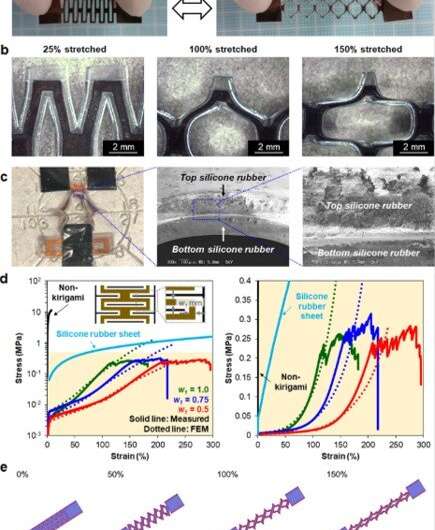
In the present work, Yamagishi et al. addressed the problem by developing a skin-contact patch containing conductive polymer nanosheet-based ultraconformable electrodes and "kirigami"-based stretchable wiring. Kirigami is a type of Japanese paper art widely employed in the field of stretchable electronics due to its flexibility. The technique can render generally unstretchable and rigid two-dimensional (2-D) materials such as graphene and carbon-nanotube nanocomposites to be stretchable via 3-D deformation. To connect nanosheet-based bioelectrodes and a bulk wearable mode, Yamagishi et al. designed and developed a kirigami-based wiring system possessing the following features.
- 2-D-membrane-based conformable skin adhesion
- Stretchability with minimal changes in resistance, and
- A fully insulated structure with a conductive layer and kirigami-patterned elastomeric insulating layers.
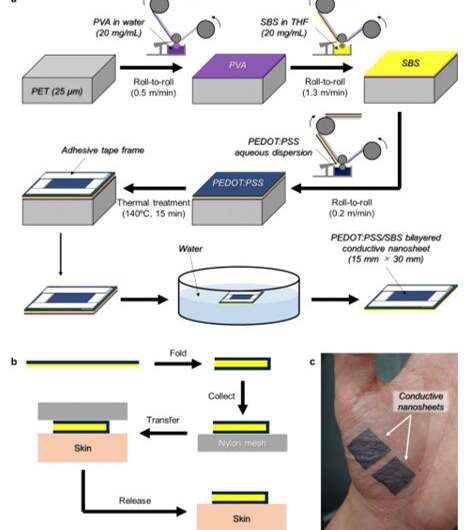
The researchers assembled the constituents to form a patch-type skin-contact device, which they named the "elastic kirigami patch." They conducted precise measurements of sEMG using the device and obtained signals from the abductor pollicis brevis muscle (APBM) during pitching by experienced baseball players. They synchronized the sEMG signals and acceleration of the arm with sequential photographs of the pitching motion using high-speed cameras.
The device developed by the scientists could measure sEMG signals from the palm in a minimally perceivable manner to the wearer. For this, they used conductive polymer ultrathin films based on poly (3,4-ethylene dioxythiophene): poly(styrene-sulfonate) (PEDOT:PSS) known as "conductive nanosheets" to form the ultraconformable skin-contact electrodes. The team had previously investigated the mechanical and electrical stability of the PEDOT:PSS-based conductive nanosheets against sweat and found them to retain electrical function with structural integrity after immersion in artificial sweat for 180 minutes. The bilayered elastic conductive nanosheets containing PEDOT:PSS and polystyrene-polybutadiene-polystyrene triblock copolymer (SBS) conformably adhered to human skin without any adhesive reagents and without interfering with the natural deformation of skin.
The PEDOT:PSS/PBS bilayered conductive nanosheet in the study had a thickness of 339 ± 91 nm, conductivity of 500 S/cm and flexural rigidity less than 10-2 nNm (nanonewton meter). The flexibility, stretchability and robust nature of the SBS nanosheet allowed the bilayered conductive nanosheet to conform to skin adhesion via van-der-Waals forces without adhesive agents. Yamagishi et al. tested the mechanical and elastic stability of the nanosheets on the palm muscle of a subject against repetitive mechanical stretching and contractions. They placed two sheets of Au-sputtered polyimide thin films on either side of the nanosheet to provide electrical contact with the nanosheets.
Thereafter, they covered the nanosheet and Au-sputtered polyimide thin films with a polyurethane-based transparent adhesive plaster. The researchers measured the resistance of the nanosheet in its initial state and after contraction/stretching of the palm muscle. They did not observe damage even after repetitive cycles of stretching and contractions to clearly demonstrate consistency of the structure and electrical property of the nanosheet electrode, even at maximum strain of the palm. The results suggest their suitability to function as bioelectrodes under repetitive cycles of stretching or contraction. The team constructed and tested the kirigami wiring system to investigate its mechanical and electrical properties and detected the mechanical properties of the wiring system using a tensile tester. The elastic wiring system demonstrated hybrid kirigami-based stretchability and silicone-rubber-based elasticity.
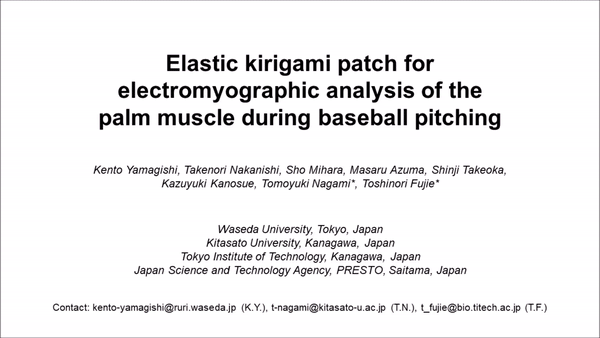
The research team then conducted extensive tests in the lab to understand the insulation property of kirigami wiring and shape recovery after elongation and contraction. To test the skin-contact device optimized with an elastic kirigami patch and a Bluetooth module, they measured electrode-skin contact impedance before and after the participants performed an arm swing. The scientists compared the results with a non-kirigami sample. Using three high-speed cameras, they captured the pitching motion of participants to investigate the SEMG signal pattern between the APBM and other muscles.
Yamagishi et al. then investigated the pitching motion in five separate phases; windup, early cocking, late cocking, acceleration and follow-through. They credited the generally observed difficulty for pitchers to control curveballs (compared with fastballs), to strengthening and weakening of APBM activity, approximately -0.5 seconds after throwing a curveball. The electromyographic analyses of the APBM during pitching motion with the intact elastic kirigami patch indicated that pitchers controlled the palm muscle activity during the early cocking phase prior to releasing the ball.
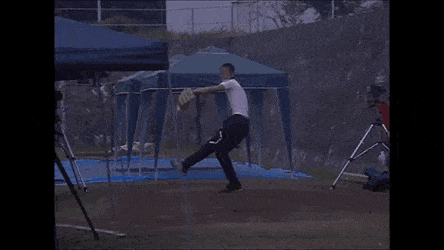
In this way, Kento Yamagishi and co-workers developed a skin-contact patch device with a kirigami-inspired stretchable wiring system and conductive nanosheet-based ultraconformable bioelectrodes. They successfully conducted dynamic sEMG analyses of the APBM muscle, which could not be tested with conventional devices during baseball pitching. The minimally perceivable device can be used to investigate the activity of muscles of athletes during exercise without interfering with their performance. The sEMG recordings observed in the work will allow researchers to obtain deeper understanding of muscle activity across a wide range of sports and movements.
More information: Kento Yamagishi et al. Elastic kirigami patch for electromyographic analysis of the palm muscle during baseball pitching, NPG Asia Materials (2019). DOI: 10.1038/s41427-019-0183-1
D.-H. Kim et al. Epidermal Electronics, Science (2011). DOI: 10.1126/science.1206157
Melina K. Blees et al. Graphene kirigami, Nature (2015). DOI: 10.1038/nature14588
© 2019 Science X Network




















